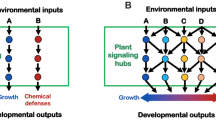Abstract
The allocation of plant internal resources to growth processes (primary metabolism) and to defensive compounds (secondary metabolism) is determined by plant internal competition for common substrates and energy. In order to contribute to the discussion about environmental impacts on this trade-off between demands for growth and defence, we extended a complex plant growth model to simulate the formation of defensive compounds on the whole plant level, depending on the dynamics of the environmental conditions light, nutrients and water. In this paper, we present and apply the model to simulate the effects of different N fertilizer applications on growth and resistance of young apple trees (cv “Golden Delicious”). The results show that model predictions are able to describe the observed relation between growth rate and phenylpropanoid concentrations in young leaves of apple trees, and can assist in the interpretation of experimental findings. Finally, we estimate costs and benefits of investment into defence in a scenario, in which an attack by the leaf pathogen Venturia inaequalis is simulated.










Similar content being viewed by others
References
Basey JM, Jenkins SH (1993) Production of chemical defenses in relation to plant growth rate. Oikos 68:323–328
Bazzaz F (1997) Allocation of resources in plants: state of the science and critical questions. In: Bazzaz F, Grace J (eds) Plant resource allocation. Academic Press, San Diego, pp 1–37
Bossel H (1996) Treedyn3 forest simulation model. Ecol Model 90:187–227
Bouma TJ, Yanai RD, Elkin AD, Hartmond U, Flores-Alva DE, Eissenstat DM (2001) Estimating age-dependent costs and benefits of roots with contrasting life span: comparing apples and oranges. New Phytol 150:685–695
Bryant J, Chapin F, Klein D (1983) Carbon/nutrient balance of boreal plants in relation to vertebrate herbivory. Oikos 40:357–368
Coley P, Bryant J, Chapin F (1985) Resource availability and plant antiherbivore defense. Science 230:895–899
Gayler S, Priesack E (2003) Platho—a simulation model for resource allocation in the plant-soil system. Technical report. http://www.sfb607.de/english/projects/c2/platho.pdf
Gayler S, Wang E, Priesack E, Schaaf T, Maidl FX (2002) Modeling biomass growth, N-uptake and phenological development of potato crop. Geoderma 105:367–383
Hamilton J, Zangerl A, DeLucia E, Berenbaum M (2001) The carbon-nutrient balance hypothesis: its raise and fall. Ecol Lett 4:86–95
Herms DA, Mattson WJ (1992) The dilemma of plants: to grow or defend. Q Rev Biol 67:283–335
Jones CG, Hartley SE (1999) A protein competition model of phenolic allocation. Oikos 86:27–44
Koricheva J (2002) The carbon-nutrient balance hypothesis is dead; long live the carbon-nutrient hypothesis? Oikos 98:537–539
Koricheva J, Larsson S, Haukioja E, Keinänen M (1998) Regulation of woody plant secondary metabolism by resource availability: hypothesis testing by means of metaanalysis. Oikos 83:212–226
Loomis W (1932) Growth differentiation balance vs. carbohydrate-nitrogen ratio. Proc Am Soc Hortic Sci 29:240–245
Lorio P (1986) Growth-differentiation balance: a basis for understanding southern pine beetle—tree interaction. For Ecol Manage 14:259–273
Mattyssek R, Schnyder H, Elstner EF, Munch JC, Pretzsch H, Sandermann H (2002) Growth and parasite defence in plants: the balance between resource sequestration and retention. Plant Biol 4:133–136
Mayr U, Michalke S, Treutter D, Feucht W (1997) Phenolic compounds of apple and their relationship to scab resistance. J Phytopathol 145:69–75
Penning de Vries FWT, Jansen DM, Berge HFM ten, Bakema A (1989) Simulation of ecophysiological processes of growth in several annual crops. Centre of Agricultural Publishing and Documentation (Pudoc), Wageningen, the Netherlands
Rühmann S, Leser C, Bannert M, Treutter D (2002) Relationship between growth, secondary metabolism, and resistance of apple. Plant Biol 4:137–143
Ritchie JT, Godwin DC, Otter-Nacke S (1987) CERES-WHEAT. A simulation model of wheat growth and development. Texas A&M University Press, College Station, Tex.
Stamp N (2003) Out of the quagmire of plant defense hypotheses. Q Rev Biol 78:23–55
Thornley JHM, Johnson IR (1990) Plant and Crop Modelling. Oxford University Press, New York
Tuomi J (1990) The panglossian paradigm and delayed inducible accumulation of foliar phenolics in mountain birch. Oikos 59:399–410
Tuomi J, Fagerstrom T, Niemela P (1991) Carbon allocation, phenotypic plasticity, and induced defense. In: Tallamy D, Raupp M (eds) Phytochemical induction by herbivores. Wiley, New York, pp 85–104
Walton EF, Wünsche JN, Palmer JW (1999) Estimation of the bioenergetic costs of fruit and other organ synthesis in apple. Physiol Plant 106:129–134
Wang E (1997) Development of a generic process-oriented model for simulation of crop growth. Herbert Utz Verlag, Munich, p 195
Wang E, Engel T (2000) Spass: a generic process-oriented crop model with versatile windows interfaces. Environ Model Software 15:179–188
Zhou Q (1995) Jahreszeitliche Veränderung und Verteilung von Trockensubstanz, Gesamtstickstoff und Kohlenhydraten bei Apfel der Sorte ‘Gloster’ auf der Unterlage M9. Dissertation, Rheinische Friedrich-Wilhelms-Universität
Acknowledgements
The authors gratefully acknowledge support by the Deutsche Forschungsgemeinschaft “DFG” (SFB 607, Growth and Parasite Defence? Competition for Resources in Economic Plants from Forestry and Agronomy).
Author information
Authors and Affiliations
Corresponding author
Rights and permissions
About this article
Cite this article
Gayler, S., Leser, C., Priesack, E. et al. Modelling the effect of environmental factors on the “trade-off” between growth and defensive compounds in young apple trees. Trees 18, 363–371 (2004). https://doi.org/10.1007/s00468-003-0315-6
Received:
Accepted:
Published:
Issue Date:
DOI: https://doi.org/10.1007/s00468-003-0315-6




